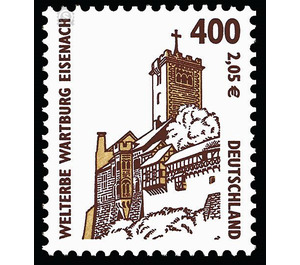Time stamp series Tourist Attractions - Germany / Federal Republic of Germany 2001 - 400 Pfennig
Theme: Architecture
| Country | Germany / Federal Republic of Germany |
| Issue Date | 2001 |
| Face Value | 400.00 |
| Perforation | K 14 |
| Stamp Type | Postage stamp |
| Item Type | Stamp |
| Chronological Issue Number | 2084 |
| Chronological Chapter | GER-BRD |
| SID | 905059 |
| In 41 Wishlists | |
The Wartburg near Eisenach in the Thuringian Forest was built around 1070. It was until 1440 the seat of the Thuringian landgraves and a center of high medieval poetry and minstrelsy. The Reformer Martin Luther, persecuted by Pope and Emperor, lived in exile from 1521 to 1522 and began translating the New Testament from Greek into German. The so-called Lutherstube is still the destination of numerous creditors and tourists. At the first bourgeois national rally of the Germans, the Wartburg Festival of student fraternities in October 1817, the Wartburg was presented as a national monument. In the second half of the 19th century, builder Carl Alexander rebuilt long-lost parts of the building such as the keep, the cathedral and the gadem on the old foundations. Because of its historical importance, the Wartburg was declared a World Heritage Site by the United Nations in December 1999.


